
Original Link: https://www.anandtech.com/show/2902
Intel Arrandale: 32nm for Notebooks, Core i5 540M Reviewed
by Anand Lal Shimpi on January 4, 2010 12:00 AM EST- Posted in
- Laptops
Clarkdale is the desktop processor, but Arrandale is strictly for my notebooks. The architecture is the same as Clarkdale. You've got a 32nm Westmere core and a 45nm chipset on the same package:
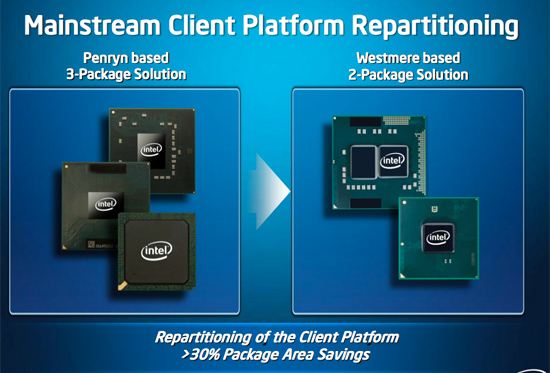
The two-chip solution does matter more for notebooks as it means that motherboards can shrink. Previously this feature was only available to OEMs who went with NVIDIA's ION platform (or GeForce 9400M as it was once known). This is the first incarnation of Intel's 32nm process so it's not quite as power optimized as we'd like. The first mainstream Arrandale CPUs are 35W TDP, compared to the 25W TDP of most thin and light notebooks based on mobile Core 2. Granted the 35W includes the graphics, but it's not always going to be lower total power consumption (more on this later).
The Arrandale lineup launching today is huge. Intel launched 7 Clarkdale CPUs, but we've got a 11 mobile Arrandale CPUs coming out today:
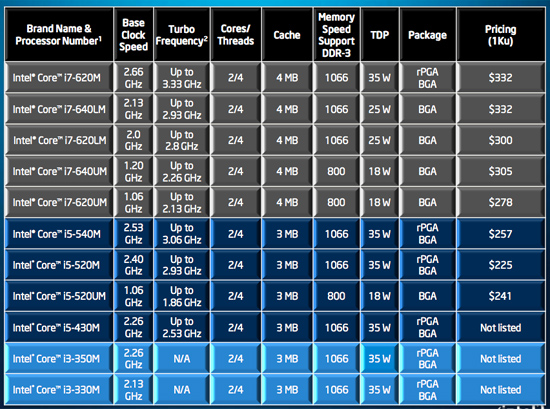
The architecture is similar to Clarkdale. You get private 256KB L2s (one per core) and a unified L3 cache for the CPU. The L3 is only 3MB (like the Pentium G9650) on the Core i5 and Core i3 processors, but it's 4MB (like the desktop Core i5/i3) on the mobile Core i7. Confused yet? I'll have to admit, Intel somehow took a potentially simple naming scheme and made it unnecessarily complex. We also get some low-voltage parts that have 18W TDPs. They run at low default clock speeds but can turbo up pretty high.
Turbo is hugely important here. While Clarkdale's Turbo isn't exactly useful, the TDPs are low enough in mobile that you can really ramp up clock speed if you aren't limited by cooling. Presumably this will allow you to have ultra high performance plugged-in modes where your CPU (and fans) can ramp up as high as possible to get great performance out of your notebook. Add an SSD and the difference between a desktop and a notebook just got even smaller.
Arrandale does have one trick that Clarkdale does not: graphics turbo.
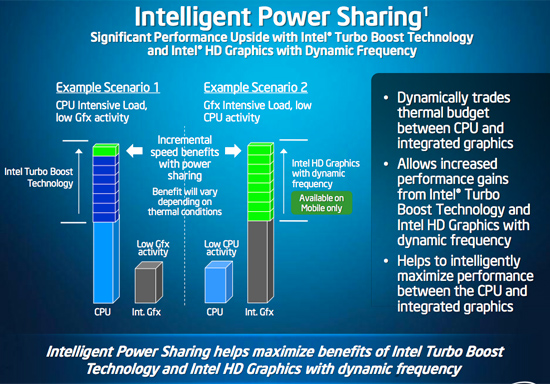
GPU bound applications (e.g. games) can force the CPU part of Arrandale into a low power state, and the GPU can use the added thermal headroom to increase its clock speed. This is a mobile only feature but it's the start of what will ultimately be the answer to achieving a balanced system. Just gotta get those Larrabee cores on-die...
Chipsets are even more complicated on the mobile side:
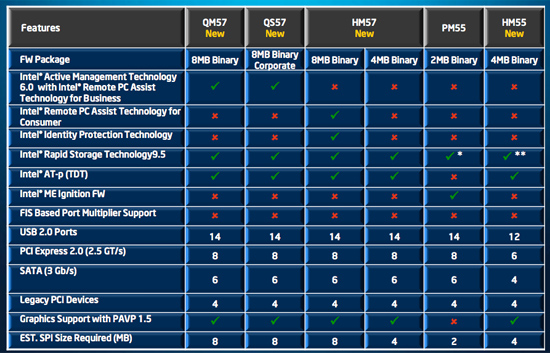
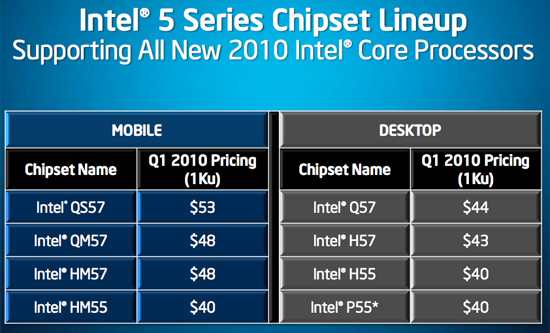
The Platform
ASUS and Intel partnered up to send us an Arrandale system to test. It's a pre-production K42 notebook.
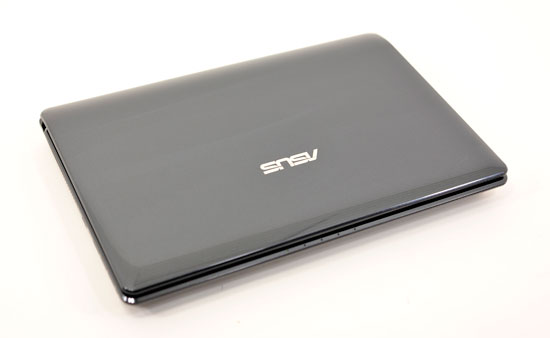
I won't comment on the build quality because honestly it's not very good. From what ASUS has told me it's already a lot better and we simply have very rough pre-production samples.
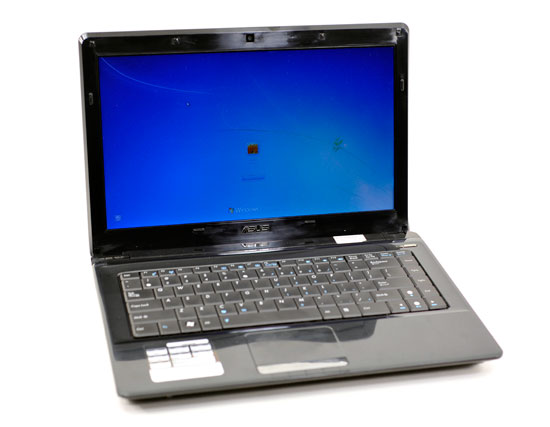
Shinebox.
As far as I'm concerned, it served its purpose as it gave me a great platform for measuring Arrandale performance.

I compared its performance to an HP Montevina system. Both systems used 4GB of DDR3-1066 and had CPUs running at 2.53GHz. The Core 2 Duo P8700 was our sample from the previous generation and we compared it to the Core i5-540M.
Performance - A Huge Improvement
There's no need for an introduction. Arrandale is going to deliver the single largest performance improvement we've seen from a new mobile processor in years. Hyper-Threading brings the many of the benefits of having a quad-core processor without the added power consumption. Turbo is also extremely useful in mobile since it's one of the most TDP-constrained environments you can imagine.
First up we have SYSMark 2007. There just isn't a better way of summing up the performance improvement:
| SYSMark 2007 | Core 2 Duo P8700 (2.53GHz) | Core i5-540M (2.53GHz) | Arrandale Advantage |
| Overall | 160 | 191 | 19.4% |
| E-Learning | 143 | 159 | 11.2% |
| Video Creation | 190 | 241 | 26.8% |
| Productivity | 160 | 178 | 11.2% |
| 3D | 150 | 194 | 29.3% |
Overall performance is almost 20% faster on a 2.53GHz Core i5-540M vs. a 2.53GHz Core 2 Duo P8700. The smallest performance difference we see here is "only" 11% while 3D rendering kicks the gap up to nearly 30%.
Cinebench R10 gives us a look at single threaded performance on the platform:
| Cinebench R10 | Core 2 Duo P8700 (2.53GHz) | Core i5-540M (2.53GHz) | Arrandale Advantage |
| Single Thread | 2814 | 3894 | 38.4% |
| Multiple Threads | 5954 | 8544 | 43.5% |
If you do any 3D rendering on your notebook but don't want to give up the form factor to go quad-core, Arrandale is your answer.
It's not all for 3D professionals. Video encoding performance, something arguably a lot more consumer-facing, gets a huge improvement as well. In our x264 HD 3.03 encoding test performance improved 26% and 46% in the first and second encoding passes respectively. Like I said before, Arrandale is fast.
| x264-HD 3.03 | Core 2 Duo P8700 (2.53GHz) | Core i5-540M (2.53GHz) | Arrandale Advantage |
| 1st Pass | 35.6 fps | 45.0 fps | 26.4% |
| 2nd Pass | 8.7 fps | 12.7 fps | 45.9% |
Photographers often like to carry around their work on notebooks so I thought I'd run our Photoshop CS4 script on the Arrandale and Core 2 platforms to see how they handled it. Surprisingly enough there was very little performance difference between the chips. The Core i5-540M was only 7% faster than the equivalently clocked Core 2. Not all of your performance gains are you going to be huge from Arrandale, but they have the potential to be (and most will be from what I've seen).
| Photoshop CS4 | Core 2 Duo P8700 (2.53GHz) | Core i5-540M (2.53GHz) | Arrandale Advantage |
| Speed Test | 35.3 seconds | 32.9 seconds | 7.3% |
Arrandale, like Clarkdale, brings the GPU on-package. Not only is it on the same package as the CPU but at 45nm it's a lot better than the previous GMA X4500 HD graphics that was in all high end Core 2 based notebooks. We saw in our Clarkdale article that Intel has basically been able to deliver integrated graphics performance equal to that of AMD's 790GX, so you can expect some decent gains here as well.
I ran our World of Warcraft test on both test systems, running at 800 x 600 at the lowest quality settings:
| World of Warcraft | Core 2 Duo P8700 (2.53GHz) | Core i5-540M (2.53GHz) | Arrandale Advantage |
| 800 x 600 - Low Quality | 19.1 fps | 43.8 fps | 129% |
Arrandale's integrated graphics is more than twice as fast. Dare I say that it's even playable? We still need to look at compatibility across a larger selection of games, but so far the latest IGP from Intel is doing much better than previous efforts.
Battery Life - Technically, No Better
Now it's time to talk about battery life. Let me run down the tests real quick. This is a combination of the tests Jarred runs in our standard notebook/netbook reviews and the tests I run in my Mac reviews. WiFi was always enabled and connected to an access point 20 feet away. The screen brightness was set to 100 nits and Windows 7 was configured to use its Power Saver battery profile.
The idle test is exactly what you think it is. The notebook just sits at the Windows 7 desktop with no screensaver active until it runs out of battery power. This is a good indication of the best battery life you'll get out of the notebook (e.g. just typing in a text document).
The light web browsing test comes from our Mac reviews and cycles through a series of web pages, pausing on each one for 20 seconds before going on to the next one. There are no flash ads on the web pages. This is the lightest load you'd see when browsing the web. A playlist of MP3s loops in the background.
The average web browsing test also comes from our Mac reviews and cycles through a series of web pages, pausing on each one for 20 seconds before going on to the next one. Each page has between 1 and 4 flash ads on it and there are three concurrent IE8 windows open, each doing the same thing. A playlist of MP3s loops in the background.
The heavy web browsing test opens four tabs in IE8, each heavily loaded with flash ads. The tabs stay open for a short period of time before the cache is cleared and the browser is closed. The system sits at the desktop for a short duration before launching IE8 once more and opening the same four tabs. The test repeats until the battery is drained. This should be close to the worst case battery life while browsing the web.
Our video playback test loops a 720p x264 movie in Media Player Classic Home Cinema x64 until the battery dies. The player uses any GPU acceleration present in the system.
Finally, the heavy downloading/multitasking test mixes a bunch of these tests together. The average web browsing test runs while a 480p XviD movie plays and while a download script executes and downloads files at a constant 500KB/s from a server.
I kept as many variables constant as possible between the two systems. Both are configured with the same amount of memory, with the same HDD and are set to the same brightness. Both systems are normalized to the same battery capacity to produce an apples-to-apples comparison of battery life.
And now, the results:
| Battery Test | Core 2 Duo P8700 (2.53GHz) | Core i5-540M (2.53GHz) | Arrandale Advantage |
| Idle | 216 minutes | 215 minutes | None |
| Light Web Browsing | 177 minutes | 188 minutes | +6% |
| Average Web Browsing | 177 minutes | 186 minutes | +5% |
| Heavy Web Browsing | 174 minutes | 176 minutes | None |
| Video Playback (x264) | 132 minutes | 134 minutes | None |
| Heavy Downloading/Multitasking | 144 minutes | 147 minutes | None |
For the most part there's actually no improvement in battery life due to Arrandale. There are a couple of instances where we see a 5 or 6% increase in staying power but these two platforms are basically equal. That's great when you consider how much faster Arrandale is than its predecessor, but it's not great when you remember that we're talking about a fully power gated 32nm processor here.
If we look at our desktop Clarkdale results we see that idle power for Intel's 32nm part isn't very good. It's actually worse than the 45nm Lynnfield platform from earlier this year. Intel confirmed that there is a lot of optimization that has to happen with Arrandale. It looks like there are some silicon level tweaks that are on the roadmap to be implemented but we won't see them until the middle of 2010. That means while the first Arrandale notebooks won't offer any more battery life than their predecessors, the second wave of Arrandale should fix that.
There's also one more thing to worry about. All of our battery life tests are carefully constructed to make sure they execute the same amount of work on all systems. Twenty seconds takes the same amount of time regardless of how fast your CPU is. As we've already seen, Arrandale is nearly 20% faster than the current mobile Core 2 Duo at the same clock speed. It is possible for you to get much worse battery life out of Arrandale simply by doing a lot more work. Intel estimates that if we were to loop Cinebench over and over again we'd see about 30% worse battery life on Arrandale vs. the previous generation mobile Core 2. The reason being that Arrandale would be much faster, but draw more power. It would be doing more work over the course of the test.
For an end user all this means is that you can do things like encode videos faster on Arrandale than you could before. You can either do the same amount of encoding, faster, without hurting battery life, or you can do more encoding, in the same amount of time, while reducing battery life. Just something to be aware of as Arrandale notebooks have the ability to be just as power efficient as existing notebooks, but can easily be more power hungry if you let them.
Final Words
From the balanced notebook perspective, Arrandale is awesome. Battery life doesn't improve, but performance goes up tremendously. The end result is better performance for hopefully the same power consumption. If you're stuck with an aging laptop it's worth the wait. If you can wait even longer we expect to see a second rev of Arrandale silicon towards the middle of the year with better power characteristics. Let's look at some other mobile markets, though.
If what you're after is raw, unadulterated performance, there are still faster options. We compared Arrandale with a Core 2 Duo P8700, and performance went up. If you already have something with a Core i7-720QM (or other i7 part) or a Core 2 Quad, the performance figures aren't nearly so rosy. The catch is that battery life on quad-core CPUs, frankly, stinks. Most of the time, you're lucky to get over 90 minutes of battery life in light loads. For those looking at mobile performance, Clarksfield is still the winner (or grab a desktop Core i7 notebook).
We are also missing something to replace the ultra-long battery life offered by the Core 2 Ultra Low Voltage (CULV) parts. True, Intel has some low voltage 18W TDP parts running at 1.06GHz to 1.20GHz stock (Turbo up to 1.86GHz to 2.26GHz depending on the model), but the current results suggest that CULV + GS45 is still going to be far more compelling for those interested in battery life while maintaining some level of performance, or you can go with Pine Trail/Pineview (Atom N450) for extreme battery life at the cost of performance. It looks like Arrandale needs some further tweaking before we see an heir to the CULV throne.
Ultimately, we like Arrandale a lot as a balanced mobile offering. It's not going to be as fast as Clarksfield but that was never the point. Performance is 20% better in typical applications compared to mobile dual-core Penryn parts like the P8000 and P9000 series, and battery life at least didn't go down (in most cases). It's also nice to see integrated Intel graphics that don't suck… or at least, they only suck as bad as the current AMD and NVIDIA IGPs. We'll look at doing more testing with Arrandale's IGP in a future article when we have final shipping hardware, as the ability to limit the CPU performance in order to boost GPU speeds is intriguing.
If you're after a "typical" laptop, Arrandale solutions should be high on your list. We expect to see a ton of announced models at CES this week, and we'll do our best to cover them (along with Pine Trial netbooks). We still can't recommend any particular laptop as a solution for every problem, as different users have different needs, but Arrandale brings more choice to the table and choice is a good thing.







